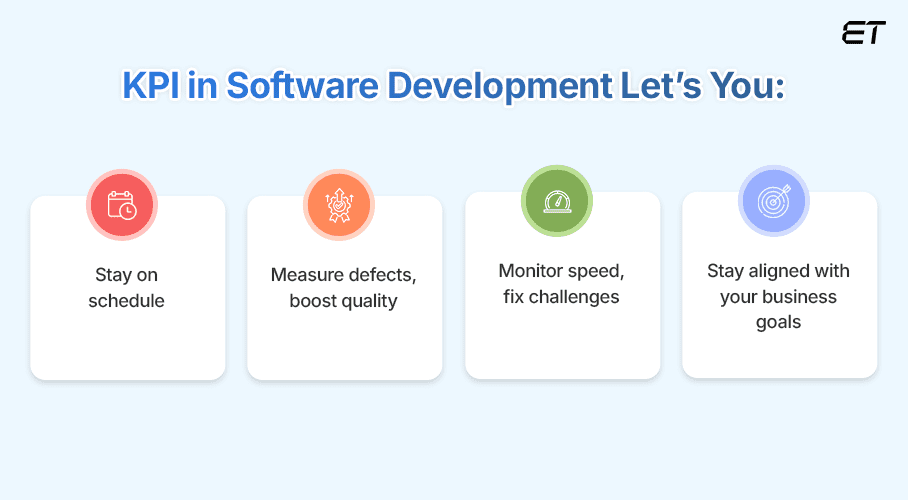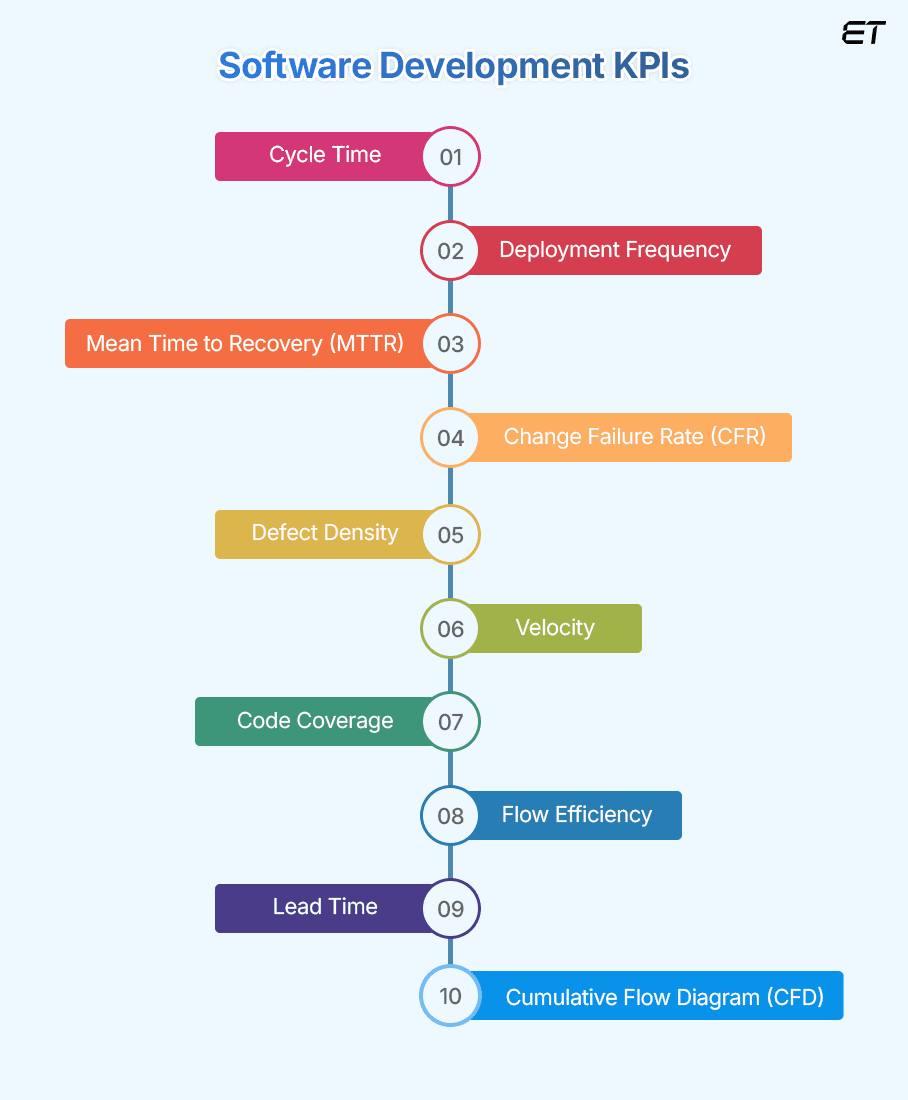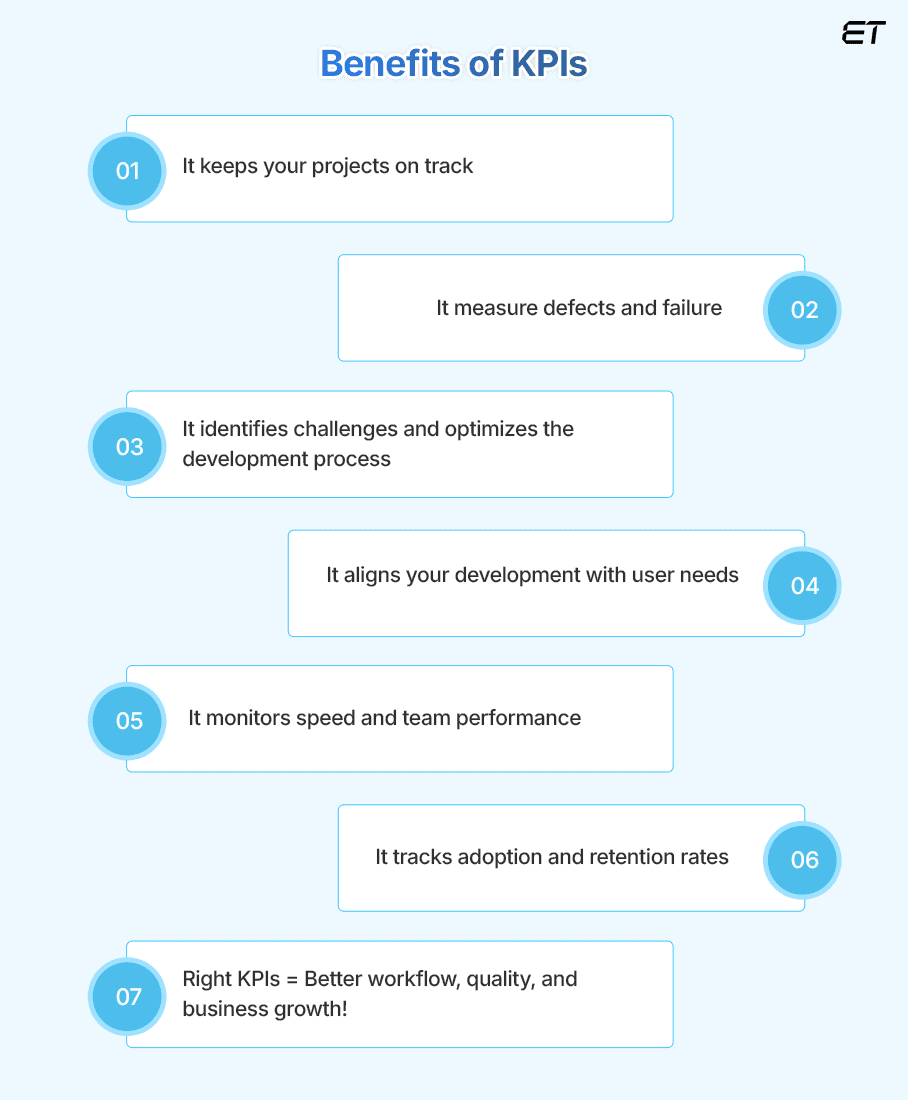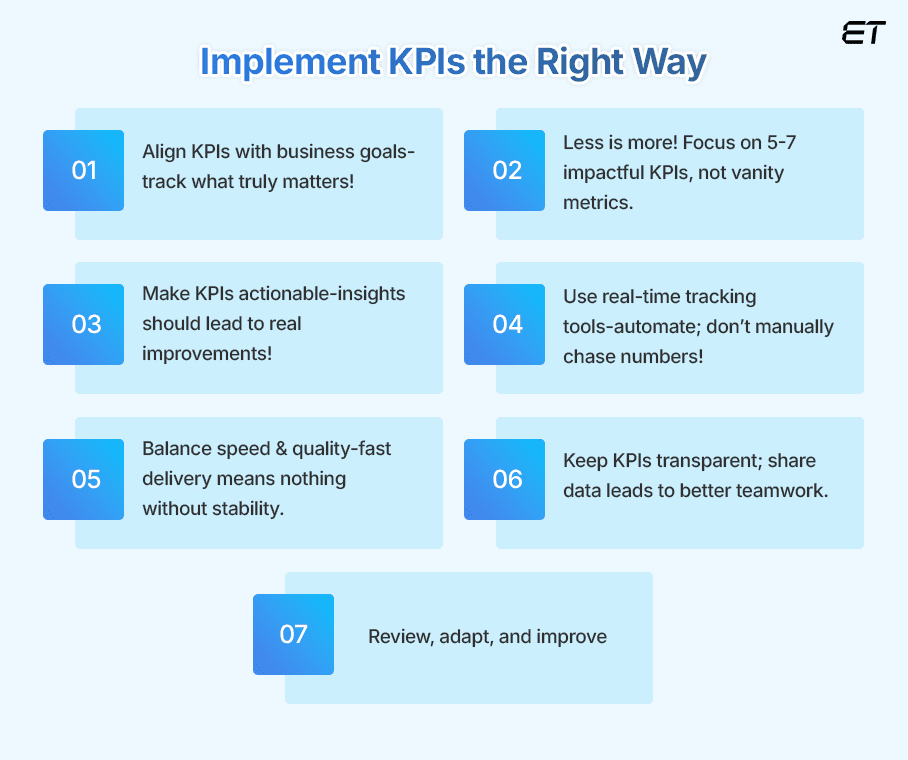
Top Software Development KPIs: Measure What Truly Matters for Your Business
Today, software development is not just about writing codes; it’s also about delivering business value. But the question is, how do you measure its success? How do you truly understand that your engineering teams are efficient, or are they stuck in a cycle of endless deployments and bug fixes without impacting the software?
This is where software development KPIs come into play. These KPIs help C-executives like you gauge the effectiveness of your development processes, identify obstructions, and ensure your efforts align with your objectives.
However, not all KPIs are created equal. You can be at fault if you track the wrong metrics, like lines of code written or the number of commits. This can lead to you ignoring crucial aspects like software quality, user adoption, and deployment efficiency.
In this blog, we’ll explore software development KPIs, the most critical metrics that high-performing engineering teams track, and how you can leverage them to drive strategic decision-making.
Let’s build data-driven software with clear KPIs and measurable success metrics!
What are KPIs for Software Development?
Key Performance Indicators (KPIs) for software development are measurable metrics that help your teams and leaders evaluate the efficiency, quality, and impact of your engineering processes. These software development KPIs provide data-driven insights into how well your software team is performing, where improvements are needed, and whether their development efforts align with your business goals.
If you’re a C-level executive, tracking the right software development KPIs is important for you. Why? Because it ensures that your teams are not just writing code but delivering high-quality, scalable, and business-impacting solutions. Without these metrics, there’s a possibility that your teams might focus on the wrong aspects, leading to inefficiencies, missed deadlines, and subpar software performance.
Why Do Software Development KPIs Matter?
Now that software development KPIs are clear to you, let’s quickly understand why these are important and matter so much in a business.
Without proper software development KPIs, your organization risks facing:

Missed deadlines: Projects may take longer than expected without tracking delivery metrics.
Low code quality: Without measuring defects and failure rates, your teams might ship buggy software.
Inefficient workflows: Without monitoring development speed, engineering challenges go unnoticed.
Lack of business alignment: Without tracking user adoption and customer satisfaction, your teams might build features that don’t add real value or miss out on one.
Therefore, by tracking the right software development KPIs, you can optimize your workflows, improve product quality, and align engineering efforts with your business growth.
Decode the best software methodologies to find the perfect fit for your next big project!
Software Development KPIs
Let’s look at the 10 software development KPIs that are essential for ensuring efficiency, quality, and alignment for your project.

1. Cycle Time
What Does It Measure?
Cycle time is a software development KPI that measures the duration of your work from the start to its completion. It encompasses the entire process, including development, testing, and deployment phases. It reflects how quickly your team can deliver a product increment or feature.
Why Does It Matters?
A shorter cycle time indicates a more efficient development process, enabling your teams to deliver features and fixes faster. This agility allows for rapid response to market changes and customer feedback, enhancing competitiveness. Conversely, prolonged cycle time can signal obstructions or inefficiencies in the workflow that need addressing.
A study analyzing 39 proprietary production codebases found that low-quality code contains 15 times more defects than high-quality code. Consequently, resolving issues in low-quality code takes, on average, 124% more time in development, thereby increasing cycle time.
2. Deployment Frequency
What Does It Measure?
This software development KPI tracks how often your team successfully deploys code to production. It reflects your team’s capability to deliver end-users new features, updates, or fixes.
Why Does It Matters?
Frequent deployments indicate a streamlined and effective development process. They allow your business to provide continuous value to customers, gather timely feedback, and stay ahead of your competitors. Infrequent deployments may suggest obstacles in the development pipeline or a lack of automation.
According to the 2023 DORA Report, elite-performing teams deploy code multiple times daily, while lower-performing teams release only a few times a year. This high deployment frequency enables rapid iteration and responsiveness to user feedback.
3. Mean Time to Recovery (MTTR)
What Does It Measure?
MTTR is a software development KPI that calculates your team’s average time to restore service after an incident or failure. It includes the time from detecting the issue to implementing a fix and returning to normal operations.
Why Does It Matters?
A lower MTTR signifies that your team can quickly address and resolve issues, minimizing downtime and its impact on users. Efficient incident response enhances system reliability and user trust. Conversely, a high MTTR can lead to prolonged outages, customer dissatisfaction, and potential revenue loss.
4. Change Failure Rate (CFR)
What Does It Measure?
CFR is a software development KPI that represents the percentage of deployments that result in a failure in production, necessitating a rollback or hotfix.
Why Does It Matters?
A high CFR indicates issues with code quality, testing, or deployment processes. Therefore, reducing the CFR is crucial for maintaining system stability and user satisfaction. It also reflects the effectiveness of your team’s quality assurance practices.
5. Defect Density
What Does It Measure?
Defect density is a software development KPI that calculates the number of defects identified per unit size of the software, such as per thousand lines of code or function points.
Why Does It Matters?
This metric provides insight into the quality and stability of the software product. A higher defect density suggests potential quality issues in your code, which could lead to increased maintenance costs and reduced user satisfaction. Monitoring defect density helps your teams identify problematic areas in the codebase that require attention.
A study titled “Code Red: The Business Impact of Code Quality” found that low-quality code contains 15 times more defects than high-quality code. This highlights the importance of maintaining high code quality to reduce defect density.
6. Velocity
What Does It Measure?
Velocity is a software development KPI that measures the amount of work your development team completes during a sprint or iteration, typically quantified in story points or tasks.
Why Does It Matters?
Understanding velocity aids you in sprint planning and setting realistic timelines. It provides a benchmark for your team’s capacity, helping you to manage expectations and allocate resources effectively. However, it’s essential that you use velocity as a planning tool rather than a performance target to avoid encouraging rushed or low-quality work.
7. Code Coverage
What Does It Measure?
Code coverage is a software development KPI that assesses the extent to which a program’s source code is tested by a particular test suite. It is usually expressed as a percentage, indicating the proportion of the codebase that is executed during testing.
Why Does It Matters?
High code coverage suggests that a significant portion of the code is tested, which can lead to the early detection of bugs and reduce the likelihood of defects in production. However, it’s essential for you to know that 100% code coverage doesn’t guarantee the absence of bugs; it merely indicates that the code has been executed during tests. Focusing solely on code coverage can lead to a false sense of security, so you should use code coverage with other quality metrics.
8. Flow Efficiency
What Does It Measure?
Flow efficiency is a software development KPI that measures the ratio of active work time to the total time taken to complete a process and is expressed as a percentage. It highlights the proportion of time spent actively working on a task versus waiting or being delayed.
Why Does It Matters?
Low flow efficiency indicates significant delays in the development process, such as waiting for approvals, clarifications, or resource availability. Improving flow efficiency can lead to faster delivery times, better resource utilization, and increased team productivity. It helps your teams identify obstructions and areas where the process can be streamlined.
9. Lead Time
What Does It Measure?
Lead time is a software development KPI that measures the total time taken from the initial conception of a feature or requirement to its final delivery to the customer. It encompasses the entire development lifecycle, including planning, development, testing, and deployment.
Why Does It Matters?
Shorter lead times indicate a more efficient development process, allowing you to respond swiftly to market demands and customer feedback. Monitoring lead time helps your teams identify delays in your development pipeline and implement strategies to accelerate delivery, therefore enhancing customer satisfaction and competitiveness.
10. Cumulative Flow Diagram (CFD)
What Does It Measure?
A cumulative flow diagram is a software development KPI that visualizes the status of work items in different stages of the development process over time. It displays the accumulation of tasks in various states, such as ‘To Do,’ ‘In Progress,’ and ‘Done,’ providing a comprehensive view of workflow dynamics.
Why Does It Matters?
CFDs help your teams monitor work in progress, identify challenges, and assess the stability of their workflow. By analyzing the diagram, you can detect process inefficiencies, manage workload distribution, and implement improvements to maintain a steady flow of work items through the system.
Build smarter with KPI-driven software. Let’s craft success together!
Benefits of KPIs for Software Development
Let’s explore some of the benefits of how software development KPIs assist your processes and how they contribute to your business success.

1. Improved Development Efficiency and Productivity
It is normal for your software teams to face challenges, long development cycles, and unclear priorities. Tracking software development KPIs like cycle time, lead time for changes, and velocity helps team managers identify inefficiencies and optimize workflows.
But how do software development KPIs boost efficiency? Let’s find out!
- It identifies delays early. If cycle time is too long, leaders can pinpoint which stages (coding, testing, or deployment) need improvement.
- It optimizes work allocation. Velocity metrics help distribute work evenly, preventing overloading and underutilization of your employees.
- It reduces obstructions. For example, if lead time is high, it may indicate delays in approvals or reviews, prompting process adjustments.
2. Higher Code Quality and Software Reliability
A software product is only as good as the quality of its code. KPIs such as defect density, change failure rate, and mean time to recovery (MTTR) help your teams maintain high standards and minimize bugs.
Let’s understand how!
- It monitors code stability. If defect density is rising, it signals a need for better testing and refactoring.
- It reduces deployment failures. If releases break frequently (high change failure rate), this calls for better QA practices.
- It speeds up the recovery of your development’s incident. A low MTTR indicates that the team can quickly resolve failures, minimizing downtime.
3. Data-Driven Decision Making
Without hard data, your decisions can often be based on assumptions. Here, KPIs provide clear, quantifiable insights into performance, allowing you to make strategic, evidence-based choices.
Let’s look at how software development KPIs assist you in making better decisions.
- They help you set realistic goals. Instead of guessing how long a project will take, KPIs like lead time for changes provide you with accurate estimates.
- It assists you in optimizing your resource allocation. For example, if your developers spend too much time fixing bugs, this signals a need for more testing resources.
- It improves your release planning. If deployment frequency is low, your team can adjust strategies to release updates faster.
4. Enhanced Team Collaboration and Accountability
When you track KPIs, you create transparency within your development teams. This ensures that everyone understands their impact on the overall process, fostering a culture of accountability and continuous improvement.
Let’s understand how software development KPIs strengthen your team collaboration.
- It encourages ownership. When engineers see how their work affects cycle time or defect rates, they take more responsibility for quality.
- It streamlines communication between your teams (e.g., development, QA, and DevOps), as clear KPIs make it easier to align priorities.
- It improves feedback loops. Metrics like code review time encourage faster feedback and better knowledge sharing.
5. Better User Experience and Customer Satisfaction
The success of any software product depends on how well it serves its users. KPIs like customer satisfaction (CSAT), net promoter score (NPS), and user adoption rate help ensure that you are delivering real value.
Let’s see how KPIs enhance user experience!
- It tracks your software’s feature effectiveness. For example, if user adoption of your newly launched feature is low, it may need design improvements.
- It improves your software stability. For example, if your software has a high MTTR, it means users are experiencing downtime frequently, which will negatively affect retention.
- It increases customer loyalty, as monitoring CSAT and NPS will help your teams adjust based on user feedback.
6. Reduced Costs and Higher ROI
Every inefficient process or buggy release costs money. However, by tracking software development KPIs, you can cut down on unnecessary expenses and maximize your ROI.
Let’s understand how KPIs can save you expenses.
- It prevents you from costly errors as it will catch defects early and will save you the cost of fixing them later.
- It optimizes your engineering efforts. If your code churn is high, it means your developers are rewriting code too often, which signals a need for better planning.
- It reduces downtime losses. If MTTR is high, outrages can lead to financial losses, making fast recovery a priority.
7. Continuous Improvement and Innovation
Software development is never static because new technology is evolving, customer needs keep shifting, and business goals are changing. KPIs provide a framework for continuous improvement, allowing your teams to identify weaknesses, optimize processes, and drive innovation.
Let’s see how software development KPIs drive continuous improvement.
- It encourages experimentation. Your teams can A/B test features and measure their success through adoption rates.
- It allows you to benchmark against industry standards and compare your business KPIs with market leaders to stay competitive.
- It allows you to adapt to changing priorities. Your agile team can adjust KPIs to focus on new challenges, such as security, scalability, or performance, basically whatever the need of the hour is.
Want smart, scalable, and result-driven software? Explore how we turn your ideas into innovation!
How to Implement KPIs Effectively into Your Software Development?
KPIs for software development aren’t just about tracking numbers but using data to drive real improvements to your business. Here’s how to implement KPIs effectively to improve your software efficiency and quality.

1. Align KPIs with your business goals: Choose KPIs that support your company’s objectives, whether it’s improving your software’s delivery speed, enhancing quality, or increasing customer satisfaction.
For example, if the goal is faster feature delivery, then track cycle time and deployment frequency. If quality is your priority, you should monitor defect density and change failure rate.
2. Select the right KPIs for your team: Avoid tracking too many KPIs, as it will get you overwhelmed and distracted from your software vision. Focus on 5-7 key metrics that truly impact performance and are aligned with your objectives.
For example, a DevOps team can prioritize Mean Time to Recovery (MTTR), and your product team could focus on User Adoption Rate.
3. Make KPIs measurable and actionable: Ensure that your KPIs are quantifiable. Each KPI should provide clear insights that lead to specific actions for improvement.
For example, if your cycle time is 10 days, you can reduce it to 5 days.
4. Use real-time monitoring tools: You can implement automation and dashboard tools like Jira, GitLab, or Linear to track KPIs in real-time.
Why? Manual tracking is inefficient, while automated tools provide live insights, helping your teams adjust strategies instantly.
5. Set benchmarks and targets: Compare your KPIs against industry benchmarks. Establish realistic goals for continuous improvement rather than aiming for perfection overnight.
6. Foster a data-driven team culture: Encourage your developers to see KPIs as tools for improvement, not performance policing. Provide regular feedback sessions where teams can discuss KPI trends and solutions collaboratively.
7. Review and adapt KPIs regularly: Business and project needs evolve with time and trends, and so should your KPIs. Conduct quarterly KPI reviews to ensure they remain relevant and adjust them as needed.
8. Integrate KPIs into your agile workflows: Align your KPI tracking with Agile ceremonies like sprint reviews and retrospectives.
For example, during sprint planning, review past sprint KPIs (like sprint velocity) to improve workload estimation.
9. Balance speed with quality: Fast software delivery is useless if code quality suffers. Therefore, for better results, combine speed-focused KPIs (cycle time, deployment frequency) with quality metrics (defect density, change failure rate).
10. Ensure transparency across teams: Make KPI data accessible to all your stakeholders (like developers, testers, product managers, and executives).
For example, you can create a shared dashboard where your teams can track progress and identify issues together.
11. Encourage experimentation and continuous improvement: You should use KPIs to test new process improvements, like automated testing or CI/CD pipelines.
For example, if the MTTR of your coding is high, you can try on-call rotations or automated alerting and then track if response times improve.
12. Avoid KPI misuse and vanity metrics: KPIs should drive real improvements, not just look good on reports.
For example, tracking lines of code (LoC) can be misleading. Remember, more code doesn’t always mean better software.
Wrapping Up!
Tracking the right KPIs isn’t just about measuring performance but about driving real improvements in your software delivery, quality, and business impact. The best KPIs depend on your company’s goals and challenges. A few scenarios that you can consider while choosing your KPI metrics are:
- For faster releases → Focus on cycle time, deployment frequency, and lead time for changes
- For high-quality software → You can track defect density, change failure rate, and code coverage
- For system stability → Monitor mean time to recovery (MTTR) and flow efficiency
- For business impact → Prioritize customer satisfaction (CSAT), net promoter score (NPS), and user adoption rate
Your key to success lies in picking KPIs that align with your objectives, tracking them consistently, and using the insights to optimize your development process. With the right metrics in place, you can build faster, better, and more impactful software.
Build software that delivers measurable KPIs and drives real impact. Let’s create success together!
Frequently Asked Questions
1. What are KPIs in software development?
software development KPIs are measurable metrics that track your team’s performance, software quality, and delivery efficiency. They help you to optimize your processes, improve your product reliability, and align them with your business goals.
2. What are the 5 KPIs?
The top five software development KPIs are:
- Cycle Time
- Deployment Frequency
- Change Failure Rate (CFR)
- Mean Time to Recovery (MTTR)
- Defect Density
These are some of the KPIs that track different aspects of your project, from performance to quality. Choose according to your project for greater success!
3. What is KRA for software development?
KRA (Key Result Areas) in software development defines specific responsibilities and goals that drive performance. It includes ensuring high-quality code, reducing technical debt, meeting sprint deadlines, improving software scalability, and enhancing the user experience. KRAs are broader than KPIs that focus on key deliverables rather than just performance metrics.
4. How to measure developer KPI?
Developer KPIs can be measured using automated tracking tools like Jira, GitLab, or Linear to track their metrics such as code churn, sprint velocity, and deployment frequency. Automated dashboards provide you real-time insights, whereas regular performance reviews ensure continuous improvement.





